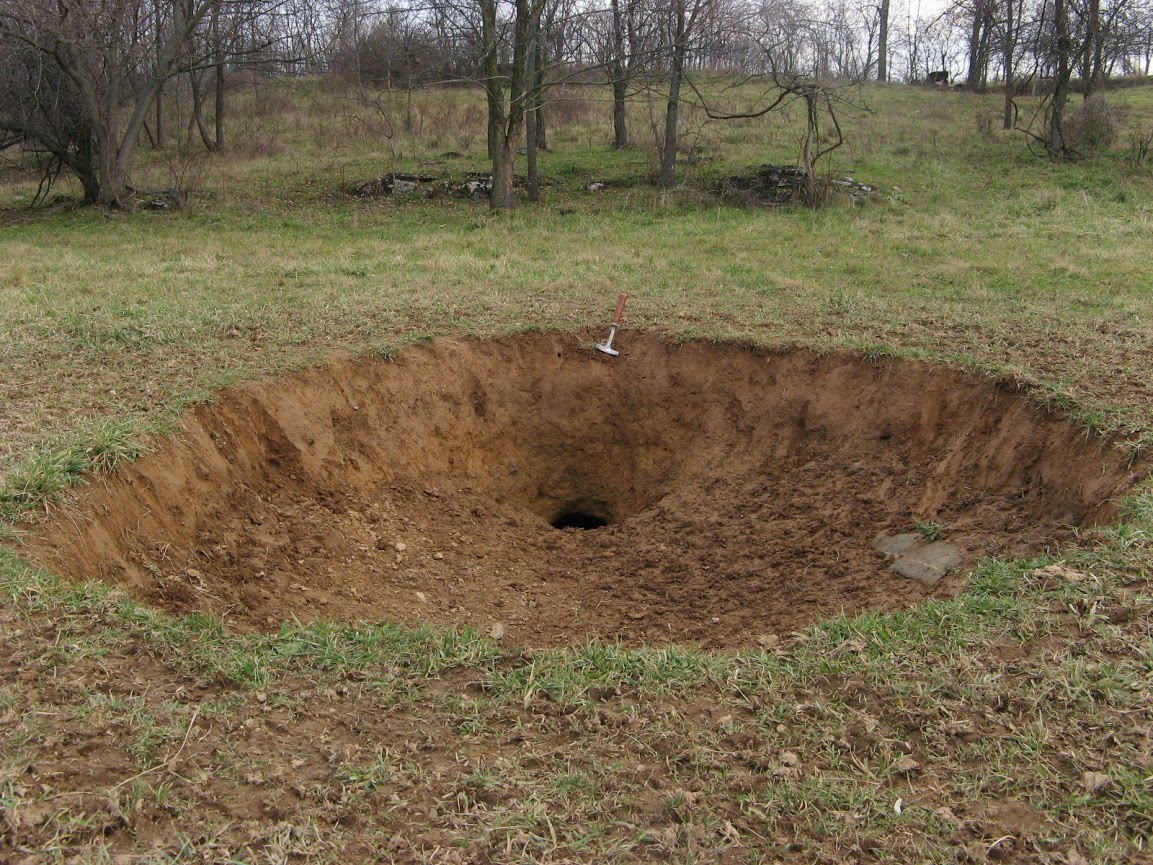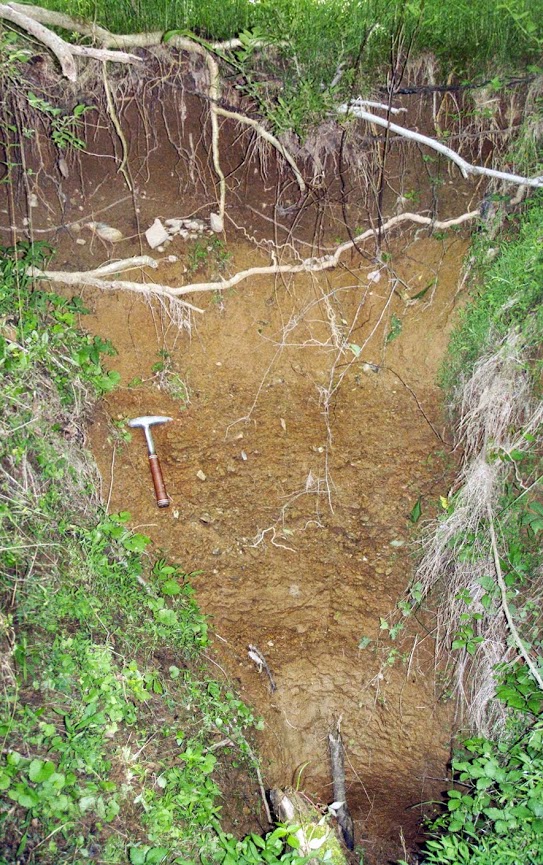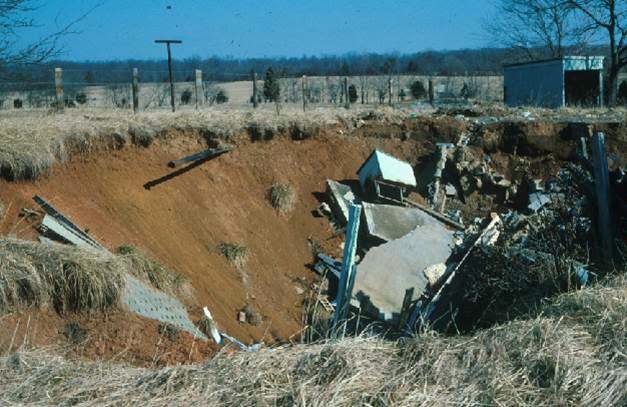
 Department of Conservation and Recreation
Department of Conservation and Recreation
Conserve. Protect. Enjoy.
 Department of Conservation and Recreation
Department of Conservation and Recreation
A sinkhole is a natural closed depression on the land surface, where runoff water sinks into the subsurface. Sinkholes are commonly found in soluble bedrock, such as limestone and dolomite. These rocks are classified as carbonate rocks, because they both contain molecules of carbon.
Water that enters the subsurface via a sinkhole may pass through (and to some extent be filtered by) a rock or sediment choke, or the water may flow directly into an underground opening large enough to transmit water. If this opening is large enough for a person to fit through then the opening is known as a cave.
 The open-throat of sinkhole in a cow wallow in Frederick County, Virginia.
The open-throat of sinkhole in a cow wallow in Frederick County, Virginia.There are two main types of sinkholes:
Sudden collapses can also occur because of subsidence of old landfills; decaying of buried organic debris; collapse of buried tanks, or rapid erosion by water from burst pipes, well, culverts, or other structures. Although these occurrences are commonly referred to in news reports as “sinkholes,” they are not related to true sinkholes.
The first type represents the most typical type of sinkhole found in landscapes underlain by carbonate bedrock; these sinkholes are common in Virginia. The second type can occur in a wide range of conditions, but the sudden natural collapse of overlying soil or rock above a subsurface void space is historically rare in Virginia.


Karst refers to a region where a particular set of landforms occur due to the dissolution of the bedrock, and in that respect it is not unlike the terms “desert,” “marsh,” “steppe” or “tundra.” The term came into broad use in the 19th century, and it is derived from the German term for the Kras region that today straddles the border between Italy and Slovenia. The Kras region is a landscape dominated by landforms that developed from dissolution of the bedrock over time, and those landforms include sinkholes, caverns, irregular (and in places exposed and pinnacled) bedrock surfaces, sinking streams in blind valleys, and large springs. The term “karst” was subsequently applied to other landscapes dominated by similar-appearing landforms. More recent definitions of karst terrain usually restrict the term to a landscape in which surface and groundwater flow systems occur within solutionally enlarged bedrock openings along pre-existing openings in the rock such as fractures, regardless of whether or not sinkholes or other surface features historically associated with karst landscapes are present. Therefore, if surface water and groundwater are both flowing over, into, and through soluble bedrock such as limestone, the presumption is that karst is present.
Karst AquifersAn aquifer is a subsurface layer or zone of porous and permeable rock, or porous and permeable unconsolidated sediment (e.g., sand or gravel) that has groundwater in its openings. Water in karst regions typically moves from sinkholes--where it is diverted from surface to subsurface pathways--to subterranean passages, and back to surface water at the spring outlet. Aquifers in karst regions can hold tremendous quantities of water because of the very large size of the openings that are commonly present in the limestone (e.g. cave passageways that are completely flooded with water).
The main differences between karst and non-karst groundwater aquifer systems are:
While sinkholes are common in many parts of Virginia, open discussion and information about sinkholes is not often a common occurrence. Therefore, sinkhole questions are not uncommon. Listed below are a few answers to some commonly asked sinkhole questions.
Where does karst occur in Virginia?
One-third of the United States east of the Mississippi River is karst terrain. With Virginia, it is estimated that 18 percent of the land area contains karst. As explained above, karst regions are located wherever soluble bedrock occurs. In Virginia, the dominant karst region is the Valley and Ridge Physiographic Province, which is comprised of most of the counties that are in the western portions of the state. The following maps provide an approximation of the major karst region in Virginia, and distribution of sinkholes. (click to enlarge)
What do I do if there is a sinkhole on my property?
If a sinkhole has opened on your property, or if you suspect that there may be the possibility of ground subsidence or collapse affecting your property, you should contact a reputable geotechnical consulting firm that is familiar with working in karst so that they may provide you with an assessment of your situation. Neither the State nor the Federal government is able to make an assessment of potential hazards to private property due to ground collapse.
Why are sinkholes a concern?
From a Virginia landowner or Virginia resident perspective, there are six main areas of potential concern:
If there are sinkhole-related laws and regulations, who administers them?
As explained in the preceding section, there are several potential sinkhole concerns; as such, there are several agencies that regulate sinkholes, and there are several potential areas of expertise needed to resolve sinkhole concerns. Although this is not a complete list of agencies with some legal jurisdiction over sinkhole-related matters, or of associated organizations, some of the primary ones, and a bulleted listing of their duties and responsibilities, are as follows:
Virginia Department of Conservation and Recreation
Virginia Cave Board
Virginia Department of Mines, Minerals and Energy
Virginia Department of Environmental Quality
Local County, Town, or City Government
Virginia Department of Transportation
Virginia Department of Emergency Management
U.S. Environmental Protection Agency (EPA)
Federal Emergency Management Agency (FEMA)
Federal Energy Regulatory Commission (FERC)
Various Local or Regional Utilities
Private Environmental Consultants
Q. Sinkholes do form suddenly in our region, don’t they? We read about road closures and building foundation failures. How could this have happened?
A. This certainly does happen, but usually these phenomena did not occur because the rock has collapsed. It is more commonly the case that such a collapse occurs where soil and sediment that fills the pre-existing network of solution-enlarged voids and conduits in the bedrock begins to move downward. This downward movement, which can be rapid, may be attributable to natural causes, such as periods of drought that lower the water table thus creating an air-filled void beneath the soil plug in a vertical chamber. In that situation, the water that was supporting the soil is gone, thereby allowing the soil to subside into the void space below, with the result that a sinkhole forms on the surface. Such a collapse can also occur where water that used to infiltrate in a dispersed manner has now been channelized and diverted in a more concentrated manner, e.g., in a culvert or ditch. As new sinkholes are created, they provide an effective conduit to transport sediment and other debris that falls into the sinkhole from the surrounding unstable land surface, and to carry this material away by the water flowing through the karst conduit. This is how a catastrophic sinkhole can quickly grow and engulf objects on the surface (e.g., buildings, cars, trees) and eventually collapse into itself. While such catastrophic sinkholes can result from natural processes, more often they are attributable to a specific human activity or activities. For example, over-pumping of groundwater from shallow wells, or dewatering at a quarry, or the channeling and diversion of stormwater into a narrow and more concentrated drainage pathway, can each lead to the erosion of underlying soil and loose unconsolidated sediment and the eventual – and perhaps catastrophic – movement away and downward from the surface. This sequence of events may leave the surface structurally unstable, and thus susceptible to the later creation and development of additional sinkholes. Something as simple as improperly directing water from roof drains and gutters away from the foundation of a structure can eventually cause a sinkhole to form along the footer or even below the slab of a house, if local geologic conditions are conducive to such phenomena.
Q. Can soil that is carried into sinkholes or caverns during the process of excavation at construction sites negatively affect a karst environment?
A. Yes, it can. The most vulnerable karst features are cave entrances and “open throat” sinkholes (i.e. sinkholes that have a visible opening in the bedrock that leads into the subsurface). Soil, uncontrolled stormwater, and pollutants absorbed onto soil particles, can each flow into these openings, where they may then enter directly into the subsurface without the benefit of any natural filtration. If there is potential for uncontrolled runoff that cannot be avoided, strict sediment and erosion control measures need to be taken during construction, and they need to be continued after construction until such time that the surrounding soil has stabilized. Every effort should be taken to direct soil and construction site runoff away from any sinkhole, but especially from a sinkhole that has a visible opening at its bottom.
Q. How can one predict where collapse of sediment into voids in the bedrock might occur?
A. One cannot predict exactly where a sinkhole might form. Nevertheless, the patterns or trends that may be present with existing sinkholes can potentially give us clues about where geologic features such as intersecting joints and fractures, or faults, or folds in the bedrock, have collectively or separately governed the development of sinkholes and resulted in sinkholes to develop and form in a particular area with greater frequency and density over time. For example, sinkholes that are aligned in a straight-line pattern probably indicate that a major solutionally enlarged fracture or other opening is present in the bedrock immediately below the surface, and that this opening has caused preferential development of sinkholes along an obvious linear trend. In addition, potential causative factors such as ponded water or greater volumes of water being channeled into karst settings, would be of particular concern and as such they would be noted and carefully inspected by knowledgeable professionals performing karst assessments. This is why preliminary surveys are so important. In addition, experienced karst geologists and soil scientists and geotechnical engineers are all aware that certain rock units tend to form cohesive, clay-rich soil layers that are prone to the development of so-called “covered karst” where these soils tend to bridge over underlying voids and hollows in the subsoil and bedrock. Known areas with this type of cohesive soil must be scrutinized very carefully during development, especially after the process of vegetation clearing which destroys the entangled root mass holding the surface soil together.
Q. Where can I learn more about karst?
A. There are many excellent references on karst and karst terrains. The following are a few examples:
The unique characteristics of sinkholes may create additional complications unless that person has some general understanding of how sinkholes may influence their environment. Three such examples include stormwater, underground injection wells and health considerations.
Stormwater
Stormwater runoff is a significant source of pollution to Virginia's surface waters. As a result, the Commonwealth and the federal government enacted several laws and regulations in an effort to lessen the spread of water pollution. Since sinkholes and karst systems can rapidly transport water, and any water-borne pollutants, the unique aspects of stormwater management within a karst landscape is relevant to a discussion of Virginia sinkholes.
In a natural hydrologic system, water falling on the land surface either slowly infiltrates into the ground, or it flows overland into streams, lakes, and rivers. Human construction activities can commonly interrupt this natural surface water flow, especially when urban or suburban development has led to areas where there is more pavement than soil, or has resulted in the construction of buildings that hinder natural infiltration into our aquifers. To manage this water within the built environment, a series of drainage pipes, ditches, culverts, channels, and other structures may have been built to move and direct surface water within a developed area. This water is referred to as stormwater, and programs that manages this water are called “stormwater management”. Stormwater usually carries pollutants; therefore most stormwater treatment systems contain a variety of facilities to treat and mitigate pollutants. These treatment facilities are also a part of the stormwater system. Also, stormwater is not supposed to carry human waste because such wastes are highly regulated, and are intended to be sent to a sewage treatment facility. Sewer and stormwater systems are supposed to be completely separated.
Underground Injection Well
Similar to the situation with stormwater, there are several federal and state laws and regulations governing the injection of surface fluids into wells or other means of entering a groundwater system. It is an important reminder that sinkholes are a connection or portal between the ground surface and groundwater. Therefore, in some situations, a person knowingly or unknowingly diverts surface water or discharges fluids into a sinkhole may legally be considered an "underground injection well," and subject to certain permits and regulations. It is for these reasons that an overview of underground injection wells is relevant to Virginia residents that live or work around sinkholes.
The injection of fluids underground is regulated by EPA’s underground injection control (UIC) program. The actual injection site is called an underground injection well. There are six classifications of injection wells, ranging from industrial waste, oil and gas, hazardous waste, and non-hazardous waste. The most typical injection well for Virginia residents is the Class V well, which includes non-hazardous fluids. Examples of fluids covered by Class V wells include stormwater, septic system leach fields, and agricultural drainage wells. The ultimate authority for managing UIC programs is derived from the federal Clean Water Act, and administered by the U. S. Environmental Protection Agency (EPA). The EPA has delegated the authority for some states to manage their own UIC program, but in Virginia, most elements of the UIC program and permitting is handled by the EPA within their Region 3 office located in Wheeling, West Virginia.
Class V (five) wells are used to inject non-hazardous fluids underground. Most Class V wells are used to dispose of wastes into or above underground sources of drinking water. This disposal can pose a threat to ground water quality if not managed properly.
The different types of Class V wells pose various threats. Most Class V wells are shallow disposal systems that depend on gravity to drain fluids directly in the ground. Over 20 well subtypes fall into the Class V category.
EPA estimates that there are more than 650,000 Class V wells in operation nationwide. Most of these Class V wells are unsophisticated shallow disposal systems. Examples include:
Health Considerations
It had been common practice for generations to dispose of trash, waste products, used motor oil, and other abandoned material, down a sinkhole. There are many reasons that this should no longer occur; perhaps the most important is that it threatens the health and safety of all local residents.

Learn more about living with sinkholes.
It is important to understand that, in general, sinkholes are natural features that serve a vital role in the ecosystem and the natural movement of water. Therefore, sinkholes should not be modified, manipulated, plugged, filled or altered without the involvement of professionals trained and experienced in working with sinkholes in Virginia.

